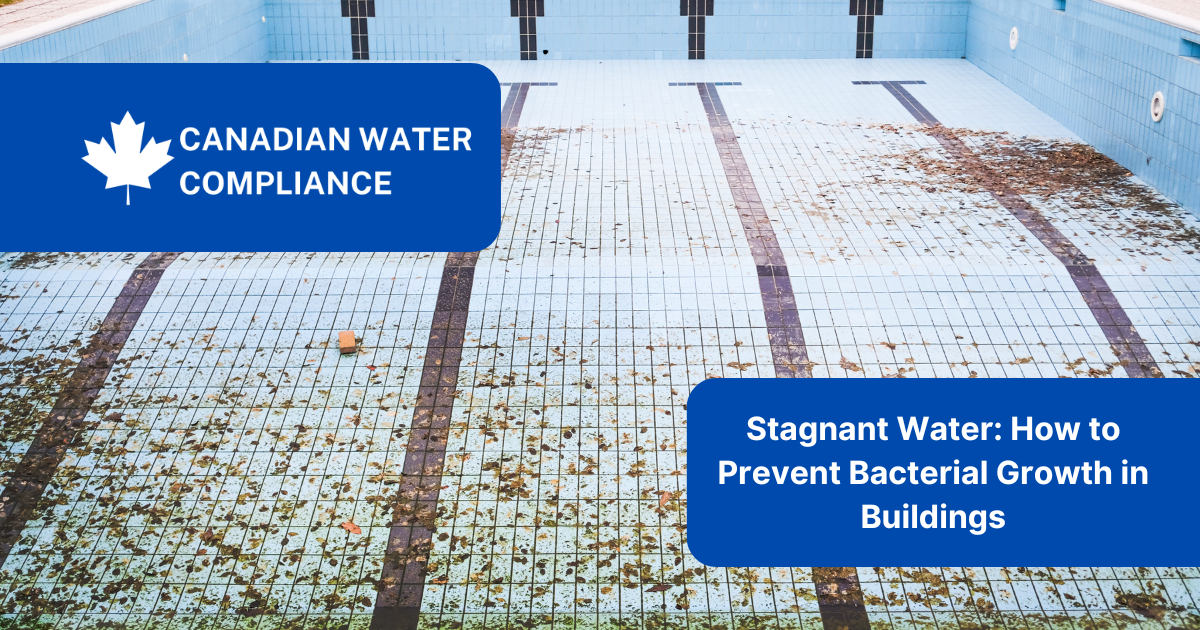
Written By: Canadian Water Compliance | On
Stagnant water in plumbing systems is a serious but often overlooked issue that can lead to bacterial growth, biofilm formation, and contamination of drinking water. When water sits unused in pipes for extended periods—whether due to seasonal building closures, low occupancy, or underused sections of a plumbing system—it creates ideal conditions for harmful bacteria like Legionella to thrive.
In this guide, we’ll cover:
What happens when water remains stagnant in a building's plumbing system
Health risks associated with stagnant water and bacterial growth
Key warning signs and water quality testing recommendations
Ontario regulations and best practices for managing stagnant water
Stagnant water occurs when water remains in pipes without flowing for extended periods. Common causes include:
🚫 Building Closures & Low Occupancy – Schools, offices, hotels, and commercial properties with reduced water usage (e.g., seasonal closures, pandemic shutdowns).
🚫 Dead-End Pipes & Unused Fixtures – Sections of plumbing that see little or no use, such as storage rooms, emergency showers, or infrequently used bathrooms.
🚫 Oversized Plumbing Systems – Large buildings with complex plumbing networks where water may sit in certain areas for extended periods.
🚫 Water Conservation Measures – While reducing water use is good for sustainability, it can sometimes lead to unintended stagnation in oversized or underused systems.
When water is stagnant, it creates conditions that allow bacteria and other contaminants to multiply. Some of the biggest risks include:
Legionella bacteria thrive in warm, stagnant water, particularly in large buildings, cooling towers, and hot water systems.
Inhalation of Legionella-contaminated water droplets (e.g., from showers, cooling towers, or faucets) can cause Legionnaires’ disease, a severe pneumonia-like illness.
Case Study: Ontario has seen multiple outbreaks of Legionnaires' disease linked to building water systems, including an outbreak in London, Ontario, in 2023.
Stagnant water allows bacteria to attach to pipe surfaces and form biofilms, which protect bacteria from disinfection treatments.
Biofilms can harbor dangerous pathogens such as Pseudomonas aeruginosa and E. coli, increasing health risks.
Standing water corrodes pipes, leading to higher levels of lead, copper, and other metals in drinking water.
This is especially concerning in buildings with older lead service lines or corroding plumbing systems.
Preventing bacterial growth in plumbing systems requires regular flushing, monitoring, and testing. Here are key strategies:
Flush all water outlets weekly if they are not in regular use.
For seasonal closures, perform an extended flushing routine before reopening.
Flush for at least 5 minutes per tap or until fresh water reaches the outlet.
Cooling Towers: Must be tested upon startup and then monthly during operation per Ontario Regulation 243/07.
Drinking Water Systems: Test for Legionella, E. coli, and coliforms in underused plumbing sections.
High-Risk Buildings: Hospitals, long-term care facilities, and hotels should routinely test for Legionella.
Keep hot water above 60°C (140°F) and cold water below 20°C (68°F) to prevent Legionella growth.
Flush hot water heaters and storage tanks regularly to prevent bacterial buildup.
Use point-of-entry filtration systems to remove contaminants before they enter the plumbing system.
Consider copper-silver ionization or chlorine dioxide treatments for Legionella control.
Ontario has specific regulations to prevent bacterial risks in water systems:
📌 Ontario Regulation 243/07 – Requires testing for lead in schools and child care centers.
📌 Safe Drinking Water Act, 2002 – Sets drinking water safety standards, including bacterial limits.
📌 Cooling Tower Regulations – Require Legionella testing and maintenance in public facilities.
Stagnant water is more than just a plumbing issue—it’s a potential health hazard. If your building has underused water systems, implementing a flushing and testing routine is essential to prevent bacterial growth and contamination risks.
🔎 Need professional water testing for Legionella or bacteria? Contact Canadian Water Compliance today for expert testing and prevention solutions!